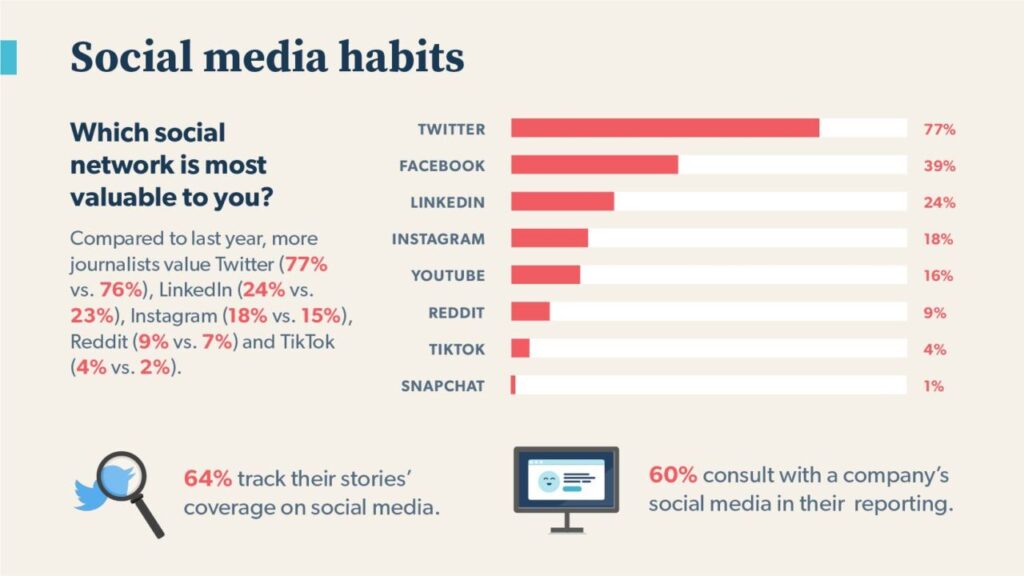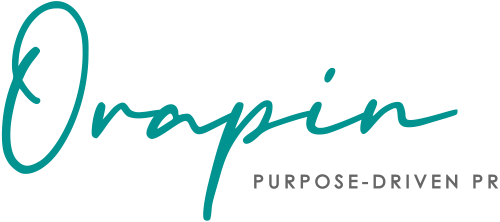
We all know the draw and power of social media, one only has to look at their weekly screen time report to know how much time is spent on our phones and scrolling social media apps. By now most businesses and organizations realize social media is a requirement in order to reach audiences, share information, and build brand or organizational affinity.
When you think of your social media audiences, think about who is getting their information from your pages. As a community support services network, your message may be tailored to reach your constituents, your volunteers, your donors, your staff, and perhaps even the general public. But, it is important to realize that journalists are also reading your social media pages and may pull story ideas from the content that you post. So how can you use this fact to your advantage? Should you adjust your social media strategy in order to target journalists specifically?
Muck Rack recently released a report on the 2022 “State of Journalism” which outlines all kinds of interesting habits and insights about our journalist friends. Their key findings on journalists’ social media habits are certainly noteworthy!
The ever-shrinking newsroom
An unfortunate trend that we’ve been witnessing over the past decade is the phenomenon of the ever-shrinking newsroom. As publication readership has shifted from print to online, most media outlets have had to make major adjustments to their operations to make up for the revenue lost from print advertising. A consequence of this lower level of profitability means that publications have downsized their workforce. This trend is particularly evident for the hometown newspapers, which in some cases have downsized their editorial staff by 30% or more.
Beyond the daily and weekly community papers and glossy print pubs, we’ve seen editorial staff reduction in broadcast outlets as well. Where in 2012 a full “news crew” including a camera person, a sound person, and a reporter would show up to film a news segment, in 2022 you’ll often get a reporter who is also recording his or her own video, or sometimes just a camera person who is there to capture the shot which will then get a voice-over during production.
The folks who are left behind have to be scrappy and resourceful and those who were laid off have either found another career or have moved into a freelance role. The Muck Rack report shares that the average journalist in 2022 covers four beats (topics/industries), up from three in 2021. Now as working professionals, we all know that the number of hours in the workweek hasn’t changed, so if the same individual is now covering more beats than they did a year ago, they’ll need to be extremely resourceful and creative in the way they gather information for their stories. Enter social media.
Journalists are on all social media platforms and you should be, too!
The Muck Rack report shows that journalists are utilizing just about every social media platform in their reporting and research; furthermore, the percentage of journalists that utilize social media platforms is growing year over year.

Image from “New Muck Rack survey: The State of Journalism 2022” | https://muckrack.com/blog/2022/03/15/state-of-journalism-2022
Twitter and LinkedIn remain the top two platforms for engagement, but every platform is gaining traction year over year. If journalists are on every platform, you should be, too! Focus your content posts and engagement efforts where journalists are most apt to be searching for knowledge and resources, but consider maintaining a presence on all available platforms.
60% of journalists consult a company’s social media channels in their reporting
We’ve talked about the importance of your online presence as a thought leader in the past, but if that didn’t convince you, this statistic should! While most companies know they need to have social media pages set up and at least make a token effort to keep them updated, consider the opportunity to potentially earn media coverage through the content you post on your social media pages. If you are a mental health services organization, you can certainly use your Facebook page or Twitter feed to post updates on upcoming clinic hours and other run-of-the-mill stuff. But also consider the opportunity that these channels provide to share your organization’s expertise and perspective on mental health issues, highlight staff members and their credentials, or showcase research and statistics. If you can entice a journalist to reference your social feeds for their stories, you will be top of mind for coverage and the first organization that they reach out to when they need an expert comment.
Key tips to engage journalists on social media:
- Repost any thought leadership content, links to blogs, podcasts, or byline articles on your social channels to make sure that content is present for journalists to find on your feed.
- Repurpose research, facts, figures, stats, and data as easily digestible infographics to showcase your expertise in your field.
- Make sure your organization’s key messages show up consistently on your social media channels. Don’t just post mundane event updates or photos, include a narrative that explains your mission, vision, and values in every post.
Journalists are looking to social media celebrities and influencers for story ideas
One interesting finding of the Muck Rack report is the fact that “more journalists say social media personalities and celebrity spokespeople are credible sources for reporting.” This is a development we find to be very interesting, it’s like the ultimate evolution of the mommy-blogger.
Social media influencers are, in short, gaining credible influence. Partnering with influencers has always been considered to be a great way for a brand to gain recognition amongst target audiences and followers – if “health-influencer Suzy” starts drinking a mushroom tea on the daily to improve brain function, then it must work, right?! But the fact that these “celebrities” have influence over journalists is a relatively new concept. So how do we apply this development to PR and marketing efforts? Well, long story short, don’t discount those celebrity and influencer partnerships. If the celebrity is talking about the important work you are doing in your community or for the world, then journalists will take notice.
Ways to engage with social media influencers and celebrities:
- Include their voices in your communications channels (both on and offline). Can you invite them to join your next expert panel or be on your podcast?
- Engage with their social media platforms by sharing and reposting relevant content from their channels to your own. Tag them in your posts that may be of interest to them.
- Create a relationship and have them become a champion for your cause. Invite them to tour your community center, have them be a guest speaker at an upcoming fundraising event, or invite them to participate in your annual charity golf tournament.
Keep those social feeds active!
The key takeaway from the Muck Rack report is that journalists are looking at just about every social media platform, so as an organization, you should view each and every platform as an opportunity and means to share your voice and thought leadership.
Furthermore, journalists are tracking their published stories’ performance on social media, so if you get a press hit, be sure to repost it and share it via every social media platform you have (as well as post it on your website, share it in your newsletter, etc.). If a journalist sees that you’re helping spread the word about their story, they’ll be more apt to reach out to you again in the future. Being a good partner to your beat reporters means meeting them where they are, so as this report would indicate, social media is a very important tool in your PR belt!

Diana Crawford is a seasoned public relations consultant with more than 15 years of agency, consulting, and in-house experience. She joined Orapin in 2013 and manages account services and client communications strategy development. She has worked across a variety of industries and has expertise with professional services, food/alcohol, health and wellness, lifestyle, sports, education, tech, and non-profit organizations.
